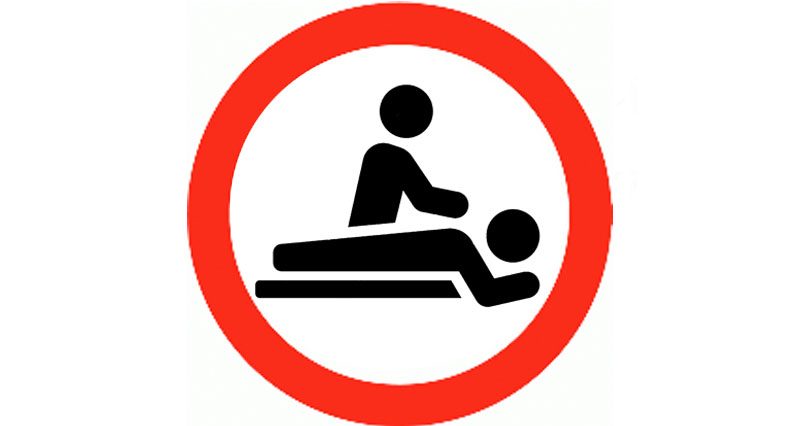Massage contraindications are injuries and conditions where using massage could be harmful or dangerous. Your therapist should always check to see if any apply to you before beginning treatment.
Below we list a number of massage contraindications but do not claim it to be an exhaustive list. Always get professional advice.
Open wounds – Any cuts, lacerations, or grazes. Obvious really, but it has to be said. You should wait until the scar has properly formed. This is usually between one and two weeks.
Muscle ruptures – In the acute stage, these may still be bleeding. Massage will increase bleeding and tissue damage and prolong recovery. After the initial 48 to 72 hours, massage may be possible but it will depend on the extent of the injury.
Tendon ruptures – The above also applies to tendon injuries. Complete ruptures are contraindications for massage and need surgery, not massage.
Muscle and tendon partial tears – Massage may be suitable after a minimum period of 48 hours, longer for more serious injuries.
Contusions – These are impact injuries causing bleeding within the muscle. Massage to a contusion too soon after the injury may cause further damage and may lead to Myositis Ossificans (bone growth within the muscle).
Burns, Chilblains, and Broken bones – Massaging all of these will hurt and cause damage. Don’t do it.
Periostitis – This is inflammation of the sheath that surrounds the bone. Massage directly to the bone may cause irritation. You may be able to massage the surrounding muscles but stay well clear of the bone.
Rheumatoid arthritis and gout – These are inflammatory conditions and massage contraindications. The same rules apply here as to acute injuries. Massage may cause further inflammation.
Bursitis – Inflammation to a bursa. A bursa is a small sack of fluid that helps tendons pass over bones at joints. If there is pain, swelling, and redness over the skin then massage should be avoided.
Myositis ossificans – A bad contusion or muscle rupture may begin to calcify (grow bone). Massage will make the damage worse.
Infections of the skin and soft tissue – Bacterial infections, viral infections, and fungal infections can be spread to other areas of the body by the therapist. Pain may also result from the infection, not an injury so massage will not help.
Thrombosis – This is a rare but potentially lethal blood clot in a vein. It is common in the calf muscle area. Deep, sore pain in the belly of the muscle may be a thrombosis. If this is massaged, it may dislodge, travel up the veins, and damage the heart.
Artificial blood vessels – Artificial blood vessels which are implanted through surgery should be avoided.
Bleeding disorders such as haemophilia – Bleeding disorders are definite massage contraindications. Using massage may cause damage to tissues and result in bleeding.
Tumors – If you are unsure of any lumps and bumps in the muscle or skin then leave well alone. Most often these lumps are muscle spasms or fatty tissue. An experienced therapist can usually tell.
Absolutely anything else you are not sure of! – Massage should only be done by qualified therapists and the writers of this site accept no responsibility for injury resulting from actions not under their direct supervision or control!
More on Sports massage








